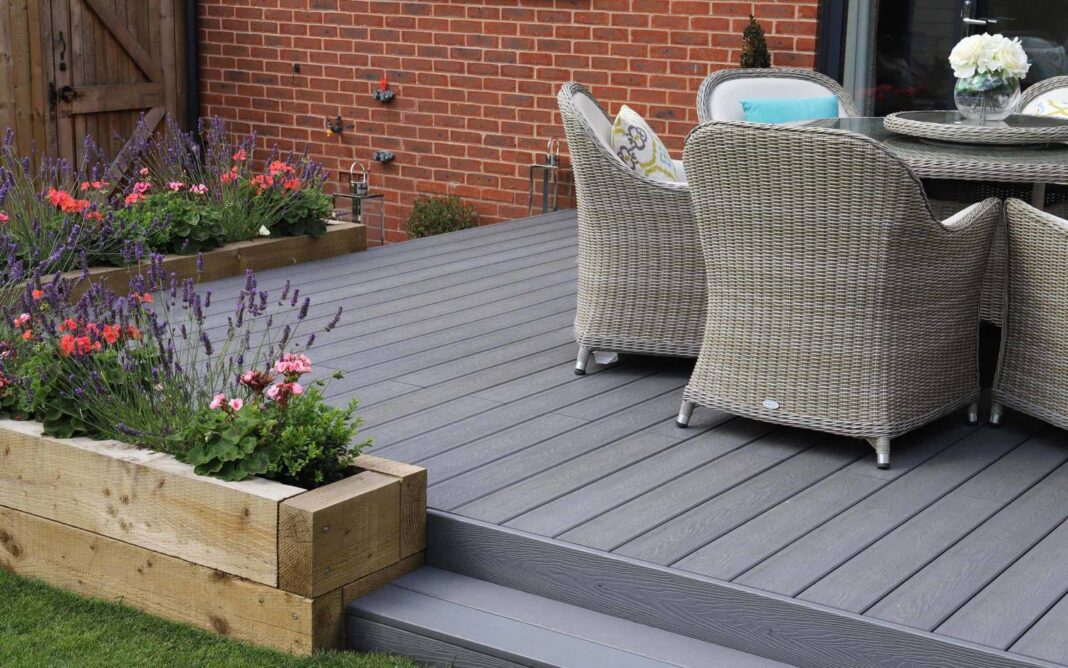Not many things in a garden are as inviting as a fully furnished deck. Even in winter, a set of rattan furniture surrounding the garden table filled with hot chocolates and marshmallows instead of steaks sizzling on the barbecue can be particularly inviting. The Dino deck didn’t become popular until the early 90s so we are in a fortunate time to be able to enjoy all of these comforts in our own back gardens. But did you know…
All decking is the same, right?
Composite decks, aside from the colour and design, may all look alike when installed. But there are actually 2 different types – hollow and solid. Hollow decking has cavities through the length of the decks, which reduces the cost and also the weight. This can make it much easier to work with and can be more practical if you are making overhead structures such as pagodas. To prevent damage, the lighter hollow decking does need more care before and during installation to prevent damage. Solid decking is more similar to natural timber. It looks heavier and is heavier, meaning it can be more difficult to move around the frame, especially if working by yourself. It gives a much more natural look but like real wood, it can be more sensitive to changes in temperature resulting in more expansion and contraction when the weather changes.
Isn’t composite decking expensive?
When budgeting for a new deck installation the budget will be a factor to consider when deciding whether to go for timber or composite decking. The initial cost for composite decking will be higher as compared to timber, but over the lifetime of the installation the treatment and maintenance costs associated with wood will vastly elevate the price. When a composite deck is installed, other than a wipe down to remove footprints and spillages from the occasionally dropped sausage it will completely take care of itself. Regardless of what weather conditions it is exposed to there will be no splintering, warping colour fading. You can be confident that for the foreseeable future, the composite deck will look the same as when it was installed. Timber, on the other hand, will require regular power washing, sanding, staining to keep the colour consistent and a final coat with varnish or wax to keep the moisture out. Moisture is the main factor associated with timber decking failing over time and however well you look after it, the water will always win the battle!
Colour co-ordination
At the time of manufacture, pigmentation is added to the formulation of composite deck boards to determine the final colour. There is no painting or staining involved. Not only does this provide a perfectly consistent colour throughout the whole board, but also allows for almost any colour board to be produced. Should you wish to make a statement with a pink yellow and green pattern, or coordinate your garden to match the local football team then that is no problem – other than the complaints from the neighbours of course! Achieving the same result with timber will be much more difficult, however, once you have decided on the final colour of your composite boards there is no going back. Timber can be repainted if you change your mind but when a composite is in, it’s in until you change the boards.
Warning!
Other than on decking, there are few occasions when you will have the opportunity to walk on wood outdoors. Timber deck that is used outdoors is very different to what you may be used to with laminate floors and real wood floors inside. The main thing to be aware of with wooden decking is how hazardous it can become in bad weather. Even a small amount of surface water can make a wooden deck dangerously slippery, even when wearing shoes that you would consider to have a substantial grip. One of the great features of composite decking boards, primarily due to their high plastic content, is that they have great anti-slip properties. Even when exposed to significant rainfall it is still safe to walk across the deck. This can be a particularly important consideration if you are planning to install a decking walkway in your garden. These are popular to traverse the garden without having to cross the lawn which in bad weather can ruin your grass and cause muddy footprints across the rest of the garden and inside your home.
Anything else you should know?
Timber decking boards are generally made in much smaller lengths than composite boards. If cut too long, timber will warp and possibly split. There is no danger of this happening with composite decks so the boards can be much longer, sometimes up to 20 feet in length. This can significantly reduce the amount of cutting required, and wastage when installing a composite deck.

